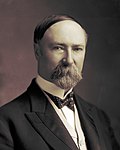| 1900 presidential election | |
  Nominees McKinley and Roosevelt | |
| Convention | |
|---|---|
| Date(s) | June 19–21, 1900 |
| City | Philadelphia, Pennsylvania |
| Venue | Convention Hall |
| Chair | Henry Cabot Lodge |
| Candidates | |
| Presidential nominee | William McKinley of Ohio |
| Vice-presidential nominee | Theodore Roosevelt of New York |
| Voting | |
| Total delegates | 926 |
| Votes needed for nomination | 464 |
| Results (president) | McKinley (OH): 926 (100%) |
| Results (vice president) | Roosevelt (NY): 925 (99.9%) Abstaining: 1 (0.1%) |
| Ballots | 1 |



The 1900 Republican National Convention was held June 19 to June 21 in the Exposition Auditorium, Philadelphia, Pennsylvania. The Exposition Auditorium was located south of the University of Pennsylvania, and the later Convention Hall was constructed along the building's east wall. It was demolished in 2006.
Contents
- State delegates
- Speakers
- June 19
- June 20
- June 21
- Vice-presidential nomination
- Vice-presidential candidates
- Candidates considered
- Platform
- See also
- References
- Bibliography
- External links
Each state was allotted two delegates per electoral vote, and territories were granted from two to six delegates. Altogether, there were 926 delegates and an equal number of alternates.
Mark Hanna opened the convention, and proposed that Senator Edward O. Wolcott of Colorado serve as temporary chairman: this was to show that the party had overcome its division in 1896, when the Colorado delegation walked out of the Republican Convention after a dispute over federal subsidies for the silver industry. Senator Henry Cabot Lodge of Massachusetts served as the convention's permanent chairman.
President William McKinley was unanimously nominated for reelection after no candidate ran against him, although Admiral George Dewey considered a run.
Governor Theodore Roosevelt of New York, who was himself a delegate, was nominated for vice president by a vote of 925 to zero, his vote alone abstaining.















